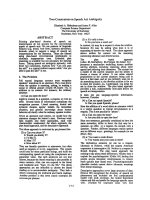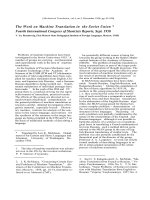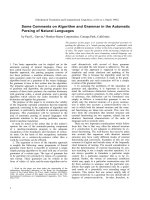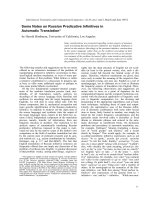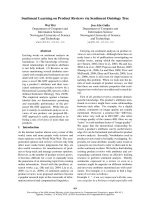Báo cáo khoa học: " Anthelmintic efficacy on Parascaris equorum in foals on Swedish studs" ppsx
Bạn đang xem bản rút gọn của tài liệu. Xem và tải ngay bản đầy đủ của tài liệu tại đây (172.7 KB, 4 trang )
BioMed Central
Page 1 of 4
(page number not for citation purposes)
Acta Veterinaria Scandinavica
Open Access
Research
Anthelmintic efficacy on Parascaris equorum in foals on Swedish
studs
Eva Osterman Lind* and Dan Christensson
Address: National Veterinary Institute, Department of Virology, Immunobiology and Parasitology, Section for Parasitological Diagnostics, SE-751
89 Uppsala, Sweden
Email: Eva Osterman Lind* - ; Dan Christensson -
* Corresponding author
Abstract
Background: In the last few years stud farms have experienced increasing problems with
Parascaris equorum infections in foals despite intensive deworming programs. This has led to the
question as to whether the anthelmintic drugs used against this parasite are failing. This study aimed
to investigate the efficacy of ivermectin, fenbendazole and pyrantel on the faecal output of ascarid
eggs of foals.
Methods: A Faecal Egg Count Reduction Test (FECRT) was performed on nine large studs in
Sweden. Anthelmintic drugs were given orally and faecal samples were examined for ascarid eggs
on the day of deworming and 14 days later. Faecal Egg Count Reductions (FECRs) were calculated
on arithmetic means of transformed individual FECRs and on arithmetic means of individual FECRs.
Results: Seventy-nine (48%) out of a total of 165 foals sampled were positive for P. equorum eggs
before deworming and 66 of these met the criteria for being used in the efficacy assessment. It was
shown that there was no, or very low activity of ivermectin on the output of ascarid eggs in the
majority of the foals, whereas for fenbendazole and pyrantel it was >90%.
Conclusion: Ivermectin resistance was shown in 5 out of 6 farms. Therefore, ivermectin should
not be the drug of choice in the control of P. equorum infections in foals. According to the results
of this study, fenbendazole or pyrantel are still effective and should be used against this parasite.
Introduction
Parascaris equorum (Nematoda: Ascaridoidea) infections
occur commonly in foals and yearlings. The horses ingest
infective eggs that are dispersed in the surrounding envi-
ronment by previous years' foals. Infections may cause
nasal discharge, coughing, ceased growth, inappetence,
rough hair coat and lethargy. At large worm burdens intes-
tinal obstruction may occur [1]. Immunity against P. equo-
rum starts to develop by the age of 6 months [2] and
horses older than 4 years seldom harbour these nema-
todes.
Generally, foals are dewormed against P. equorum several
times during their first 12 months of life. Anthelmintic
drugs registered in Sweden for this purpose include three
drug classes: benzimidazoles (fenbendazole and feban-
tel), tetrahydropyrimidines (pyrantel) and macrocyclic
lactones (ivermectin and moxidectin). During the last few
Published: 22 November 2009
Acta Veterinaria Scandinavica 2009, 51:45 doi:10.1186/1751-0147-51-45
Received: 7 August 2009
Accepted: 22 November 2009
This article is available from: />© 2009 Lind and Christensson; licensee BioMed Central Ltd.
This is an Open Access article distributed under the terms of the Creative Commons Attribution License ( />),
which permits unrestricted use, distribution, and reproduction in any medium, provided the original work is properly cited.
Acta Veterinaria Scandinavica 2009, 51:45 />Page 2 of 4
(page number not for citation purposes)
years it has been noticed on several Swedish stud farms
that foals pass mature ascarid worms with faeces shortly
after deworming. Also, obstruction and rupture of the
intestine have occurred in foals that have been rigorously
dewormed according to veterinarians' recommendations.
Recently, it was demonstrated that foals on a stud farm
excreted high numbers of ascarid eggs despite ivermectin
treatment every 8
th
week [3]. These observations have
raised the question as to whether the registered drugs are
ineffective against P. equorum. In 2000, resistance to mac-
rocyclic lactones in P. equorum was suspected on a trotter
stud in the Netherlands [4]. Later, the possibility of iver-
mectin resistance was also reported from North America
[5-7], Germany [8] and Denmark [9].
The aim of this field study was to: 1) determine the effi-
cacy of ivermectin, pyrantel and fenbendazole on the fae-
cal output of P. equorum eggs passed by foals on 9 big stud
farms; and 2) investigate the occurrence of P. equorum
infections on these studs.
Materials and methods
A total of 165 foals bred and housed on nine big studs in
Sweden were included in a Faecal Egg Count Reduction
test (FECRT). The study took place in the autumn of 2005,
after weaning (table 1). In eight of the studs the horses
were Swedish standardbred racing trotters and in one they
were half bred riding horses. All of the studs routinely
accommodate external mares during the breeding season.
The median age of the foals was 6.5 months and they had
been dewormed 2 or 3 times during the summer prior to
the study.
One group of foals on each of 7 studs, and 2 groups on 2
studs, were treated with anthelmintic drugs in the follow-
ing way: ivermectin (6 groups, Bimectin
®1
/Ivomec
®2
/
Noromectin
®3
), fenbendazole (3 groups, Axilur
®4
), pyran-
tel embonate (1 group, Banminth
®5
) or ivermectin + pyr-
antel embonate (1 group, Noromectin
®
+ Banminth
®
). The
weights of the foals were estimated visually by an experi-
enced local veterinarian/horse manager and rounded up
to the nearest 50 kg. The veterinarian/manager adminis-
tered the drugs orally according to the manufacturers' rec-
ommendations. A faecal sample was taken from each foal
on the day of treatment (day 0) and 14 days later (day 14).
These samples were placed in plastic bags, which were
sealed and sent to the laboratory of the National Veteri-
nary Institute. The numbers of ascarid and strongyle eggs
per gram faeces (EPG) were determined by a modified
McMaster technique with a lowest detection level of 50
EPG [10]. Calculations on the efficacy of the anthelmintic
drugs were performed on samples that contained 100 EPG
or more of Parascaris equorum on day 0. On stud No. 9,
there were only 2 foals (out of 18) excreting sufficient
numbers of eggs.
The foals were distributed into age groups depending on
age (months) at the time for sampling. Age differences in
the faecal output of eggs were analysed with 1-factor
ANOVA (using the SYSTAT v. 5.1 program) on log-trans-
formed values as the data better fitted a lognormal distri-
bution. The Faecal Egg Count Reductions (FECRs) were
calculated in two ways: arithmetic means of transformed
individual FECRs according to Pook et. al. [[11], Method
2], and arithmetic means of individual FECRs. Individual
faecal egg count reduction (FECR) was calculated in the
following way: FECR = (1-(EPG
d14
/EPG
d0
)) × 100%
Results
Approximately half (48%) of the 165 foals excreted eggs
of Parascaris equorum at the first sampling occasion (table
1). Sixty-six of these met the criteria for being included in
the FECR calculations. The output of eggs did not differ
significantly between foals of different ages (1-factor
ANOVA: p = 0.231; 1-factor ANOVA on log-transformed
data: p = 0.590).
Table 1: Data on foals/studs sampled in the study.
Farm
id
Age (wks) at 1
st
AH treat No AH treat 1
st
year AH used prior to study Number of foals sampled % inf
P. equorum d 0
1 8 6 pyr 15 60
28 3 iv 19 37
36 6 iv 17 47
46 7 iv 23 52
5 8 6 fbz 14 43
64 5 iv 18 56
78 6 iv 19 84
81 5 iv 22 41
9 8 6 iv + pyr 18 11
Overall 165 48
Wks - weeks; AH - anthelmintic; treat - treatment; inf - infected; d 0 - the day of AH treatment.
Acta Veterinaria Scandinavica 2009, 51:45 />Page 3 of 4
(page number not for citation purposes)
The FECR following ivermectin treatment varied from 0-
100%, with a mean reduction of 50% (transformed val-
ues) and 36% (individual FECRs) (table 2). Depending
on the calculation method, the lower 95% confidence
intervals varied from 0%-20% and 0%-60%, respectively.
In all but one stud where ivermectin was used, the FECR
was lower than 90%. On studs No. 3, 4 and 6 all the foals
included in the study were shedding P. equorum eggs 14
days following ivermectin treatment.
In the fenbendazole treated groups the FECR was 100%
and no foals were excreting ascarid eggs 14 days after
deworming (table 2). Also, in the 9 horses that had been
treated with pyrantel the reduction of eggs was more than
90% (table 2).
Discussion
The prevalence of Parascaris equorum in foals is known to
be high, commonly in the range 31-61% [12]. The finding
of P. equorum eggs in 48% of the samples before
anthelmintic treatment was within the range for what
could be expected in the autumn.
The most striking result from this study was that in 5 studs
out of 6, ivermectin treatment failed to suppress the faecal
output of P. equorum eggs. Several foals were even excret-
ing higher numbers of ascarid eggs following ivermectin
deworming, some of them more than 2000 EPG. Since the
same pattern was seen in several farms it is unlikely that
under-dosing could explain the low reduction of P. equo-
rum eggs. Moreover, no strongyle eggs were found in the
samples of the ivermectin-treated individuals, which indi-
cates that the horses had been dosed correctly.
Since the mid 1980s, the ivermectin drugs have been mar-
keted and used successfully to control nematodes in
horses. There are several studies published where ivermec-
tin has been shown to have 100% effect against adult
stages of P. equorum [13-16]. Moreover, anthelmintic
resistance in P. equorum has been considered to be
improbable because a great proportion of the parasite
population, the long-living eggs in the environment, are
in so called refugia, that is they are not exposed to the drug
and thus are not selected for resistance. Still, ivermectin
resistance in P. equorum has recently been reported from
both Europe and North America. The present study clearly
shows that ivermectin resistance is now a widespread
problem in Swedish stud farms.
Reduced efficacy of ivermectin against P. equorum was
noticed for the first time in a Swedish stud in 1997. Since
then, the development of resistance appears to have accel-
erated in response to excessive, sometimes exclusive use of
ivermectin in foals. For two decades, foals on studs have
commonly been treated every 8
th
week with ivermectin,
and over the years this might have resulted in a decreased
proportion of susceptible genotypes in refugia. Significant
traffic of mares and foals between horse premises has
probably contributed to an effective spread of resistant
genotypes, as discussed by Reinemeyer [17].
In the 3 groups where fenbendazole was tested the egg
reduction was 100%. This was in accordance with a Cana-
dian study [7]. A reduction of 100% following fenbenda-
zole treatment was also obtained in a recent FECRT of 24
Swedish foals (Osterman Lind, unpublished data).
Table 2: Faecal Egg Count Reduction Test performed on 9 studs.
Farm AH Group size* Group mean EPG d 0 Group mean EPG d 14 Max EPG d 0 Max
EPG d 14
FECR
1
d 14
FECR
2
d 14
1 iv 6 525 58 1100 200 78% 85%
2 iv 7 336 0 1350 0 100% 100%
3 iv 7 1157 721 4000 2300 7% 11%
4 iv 7 900 907 2600 1500 2% 0%
5 iv 6 283 125 500 250 24% 56%
6 iv 9 1194 961 3500 2200 1% 0%
4 fbz 3 1417 0 3550 0 100% 100%
7 fbz 5 700 0 1000 0 100% 100%
8 fbz 5 1750 0 2900 0 100% 100%
7 pyr 9 1133 34 2400 200 94% 93%
9 iv+pyr 2 125 5 150 10 91% 95%
AH - anthelmintic; iv - ivermectin; fbz - fenbendazole; pyr - pyrantel; EPG - number of eggs per gram faeces; mean EPG - arithmetic mean; d 0 - day
of anthelmintic treatment; d 14 - 14 days following anthelmintic treatment; FECR - Faecal Egg Count Reduction.
* Only foals with at least 100 EPG included
1
Arithmetic means of transformed individual FECRs (Pook et al. 2002)
2
Arithmetic means of individual FECRs
Publish with BioMed Central and every
scientist can read your work free of charge
"BioMed Central will be the most significant development for
disseminating the results of biomedical research in our lifetime."
Sir Paul Nurse, Cancer Research UK
Your research papers will be:
available free of charge to the entire biomedical community
peer reviewed and published immediately upon acceptance
cited in PubMed and archived on PubMed Central
yours — you keep the copyright
Submit your manuscript here:
/>BioMedcentral
Acta Veterinaria Scandinavica 2009, 51:45 />Page 4 of 4
(page number not for citation purposes)
The efficacy of pyrantel was >90%, but since there were
only 9 individuals on one farm that received pyrantel, the
existence of pyrantel resistance in P. equorum cannot be
ruled out. However, the Canadian study [7], as well as
unpublished Swedish data on 25 foals (Osterman Lind),
also showed a high efficacy of pyrantel.
Conclusion
Ivermectin resistance in P. equorum was detected in 5 out
of 6 equine farms. Fenbendazole and pyrantel, on the
other hand, were both effective in reducing the faecal out-
put of ascarid eggs. On most of the premises included in
the study, the deworming practices of foals have now been
changed. Instead of ivermectin, fenbendazole or pyrantel
are now the drugs of choice for use against P. equorum. It
is important, however, that the anthelmintic efficacy is
monitored routinely by FECRT on these breeding
premises. In the long-term it is also necessary to incorpo-
rate non-chemotherapeutic methods to a greater extent to
control parasite infections on stud farms.
Competing interests
The authors declare that they have no competing interests.
Authors' contributions
Both authors designed the study and interpreted the
results. EOL drafted the manuscript, which was read and
approved by DC.
References
1. Cribb NC, Coté NM, Bouré LP, Peregrine AS: Acute small intesti-
nal obstruction associated with Parascaris equorum infection
in young horses: 25 cases (1985-2004). N Z Vet J 2006,
54(6):338-343.
2. Clayton HM: Ascarids: Recent advances. In The Veterinary Clinics
of North America: Equine Practice Edited by: Heard RP. Philadelphia: W.
B. Saunders Company; 1986:313-328.
3. Lindgren K, Ljungvall Ö, Nilsson O, Ljungström B-L, Lindahl C,
Höglund J: Parascaris equorum in foals and in their environ-
ment on a Swedish stud farm, with notes on treatment fail-
ure of ivermectin. Vet Parasitol 2008, 151:337-343.
4. Boersema JH, Eysker M, Nas JWM: Apparent resistance of Paras-
caris equorum to macrocyclic lactones. Vet Rec 2002,
150:279-281.
5. Hearn FP, Peregrine AS: Identification of foals infected with Par-
ascaris equorum apparently resistant to ivermectin. J Am Vet
Med Ass 2003, 15:482-485.
6. Lyons ET, Tolliver BS, Collins SS: Field studies on endoparasites
of Thoroughbred foals on seven farms in central Kentucky in
2004. Parasitol Res 2006, 98:496-500.
7. Slocombe JO, de Gannes RV, Lake MC: Macrocyclic lactone-
resistant Parascaris equorum on stud farms in Canada and
effectiveness of fenbendazole and pyrantel pamoate. Vet Par-
asitol 2007, 145:371-376.
8. Samson-Himmelstjerna Gv, Fritzen B, Demeler J, Schürmann S, Rohn
K, Schnieder T, Epe C: Cases of reduced cyathostomin egg-
reappearance period and failure of Parascaris equorum egg
count reduction following ivermectin treatment as well as
survey on pyrantel efficacy on German horse farms. Vet Par-
asitol 2007, 144:74-80.
9. Schougaard H, Nielsen MK: Apparent ivermectin resistance of
Parascaris equorum in foals in Denmark. Vet Rec 2007,
160:439-440.
10. Anonymous: Manual of Veterinary Parasitological Laboratory Techniques
London: Ministry of Agriculture Fisheries and Food; 1986:24.
11. Pook JF, Power ML, Sangster NC, Hodgson JL, Hodgson DR: Evalu-
ation of tests for anthelmintic resistance in cyathostomes.
Vet Parasitol 2002, 106:331-343.
12. Austin SM, DiPietro JA, Foreman JH, Baker GJ, Todd KSJ: Parascaris
equorum infections in horses. Comp Cont Educ Pract Vet 1990,
12:1110-1119.
13. DiPietro JA, Lock TF, Todd KS, Reuter VE: Evaluation of ivermec-
tin paste in the treatment of ponies for Parascaris equorum
infections. J Am Vet Med Ass 1987, 190:1181-1183.
14. DiPietro JA, Todd KS: Chemotherapeutic treatment of larvae
and migratory stages of Parascaris equorum. Proceedings of the
Thirty-Fourth Annual Convention of the American Association of Equine
Practitioners 1988:611-618.
15. French DD, Klei TR, Taylor HW, Chapman MR, Wright FR: Efficacy
of ivermectin in the oral paste formulation against naturally
acquired adult and larval stages of Parascaris equorum in pony
foals. Am J Vet Res 1988, 49:1000-1003.
16. Daurio CPaL HD: The effect of oral ivermectin on immature
ascarids in foals. Equine Vet Sci 1989, 9:312-315.
17. Reinemeyer CR: Diagnosis and control of anthelmintic-resist-
ant Parascaris equorum. Parasites and Vectors 2009, 2(Suppl 2):S8.


